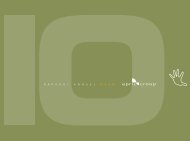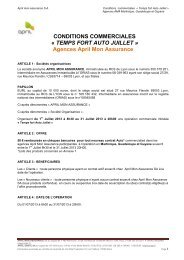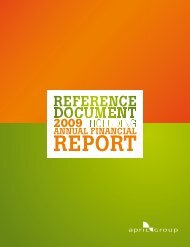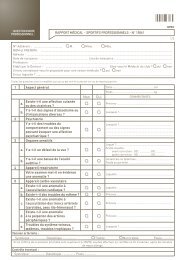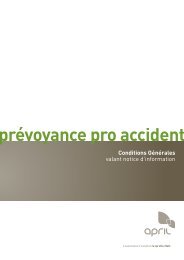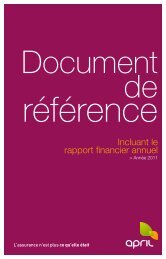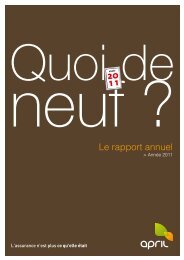2007 - April
2007 - April
2007 - April
You also want an ePaper? Increase the reach of your titles
YUMPU automatically turns print PDFs into web optimized ePapers that Google loves.
1.0<br />
Management report<br />
Lastly, he works with the findings and recommendations set<br />
out by the internal audit manager in connection with their<br />
audit assignments and the assignments carried out by other<br />
players, including financial controllers, business division<br />
auditors, Statutory Auditors, etc.<br />
The risk manager informs and advises the Group Committee,<br />
and reports on this mission to the Sustainable Development<br />
Committee.<br />
Each type of risk is subject to an in-depth review, with a risk<br />
map and action plan drawn up for each company, aimed<br />
at eliminating, transferring or reducing the residual risk.<br />
The company’s managers are responsible for implementing<br />
the action plan defined in connection with the audits or<br />
mappings, formally reporting on them at least once a year at<br />
June’s Strategic Committee meeting.<br />
At the same time, the Group internal audit manager ensures<br />
the coherency and efficiency of internal control within Group<br />
companies. Lastly, he coordinates and controls the activities<br />
of all the Group’s internal audit departments.<br />
An annual audit plan is drawn up, factoring in the exposure to<br />
risks in the various Group companies. This plan concerns all<br />
the companies in the Group. The plan for Year N is validated<br />
at the end of Year N-1 by the Group Committee. It is formally<br />
reviewed and presented to the Sustainable Development<br />
Committee twice a year for follow-up. It may also be updated<br />
as and when necessary according to the priorities identified<br />
over the course of the year.<br />
This concerns several types of assignments: cross-business<br />
assignments and optimization issues, specific audit and<br />
control assignments, assignments to monitor companies<br />
that have recently been incorporated into the Group,<br />
and assignments to follow up on previous audits. These<br />
assignments are carried out in line with the internal audit<br />
charter, a set of standards that all of the managers of Group<br />
companies are familiar with.<br />
A written report is drafted along with a synopsis of the<br />
recommendations issued further to all such missions, rated<br />
based on three categories: high risk, moderate risk and<br />
low risk. For each recommendation, a deadline is set and a<br />
manager appointed.<br />
The application of recommendations is monitored through<br />
follow-up missions during which progress made against the<br />
planned deadlines and recommendations is checked.<br />
In <strong>2007</strong>, 12 internal audit missions were carried out in eight<br />
Group companies, notably covering the following issues:<br />
intellectual protection within the Group, review of insurance<br />
policies, application of the French law on intermediation, preclosing<br />
process, compensation and IT risks. In addition, two<br />
integration follow-up audits were carried out on companies<br />
that joined the Group in 2005.<br />
All of this work aims to consolidate the internal control<br />
process within Group companies.<br />
Market risk (interest rate, foreign exchange, equity, credit)<br />
Link between the business and the risks identified<br />
APRIL GROUP’s business is based around two key areas<br />
with significantly different approaches to market risks:<br />
brokerage, which does not expose the Group to market<br />
risks, and insurance companies, for which market risk<br />
management represents one of their core businesses.<br />
Brokerage<br />
Through its activity and financial model, where cash-flow<br />
generates a negative working capital requirement, the<br />
brokerage business enables the Group to achieve a particularly<br />
low level of debt (total financial debt of only 30,305 thousand<br />
euros on the consolidated balance sheet) and a very high level<br />
of liquidity (177,718 thousand euros in net cash and cash<br />
equivalents on the consolidated balance sheet).<br />
The Group’s financial debt primarily comprises a subordinated<br />
loan representing 1,524 thousand euros, 10,703 thousand<br />
euros in various bank borrowings, 2,294 thousand euros<br />
in credit current accounts and 15,118 thousand euros in<br />
financial liabilities resulting from commitments to buy out<br />
minority interests.<br />
The Group’s cash-flow, excluding current bank borrowings, is<br />
invested in full in short-term financial investments (96,568<br />
thousand euros at December 31 st , <strong>2007</strong>) primarily through a<br />
dedicated “monetary equivalent” UCITS (APRIL Trésorerie).<br />
Insurance companies<br />
One of the basic functions of the insurance business involves<br />
investing premiums received from clients, pending payments<br />
for any claims incurred.<br />
56<br />
Return to the contents section



